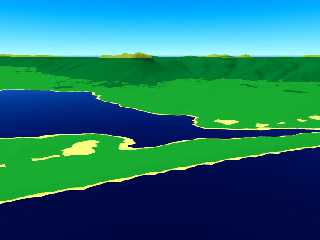|
 |
High!
Meanwhile, I got some raw version of the vegetation texture for southern
Tasmania (just a heightfield exercise in between, don't worry, I'll
switch back to Khyberspace as soon as possible!) ready... it consists of
a texture_map containing five texture_maps, each of them again is a
slope pattern containing two or three basic textures:
// Basic textures
#declare T_Beach=
texture
{
pigment { color rgb <1, 1, 0.5> }
finish { ambient 0.05 diffuse 1 brilliance 0.25 }
}
#declare T_Meadow=
texture
{
pigment { color rgb <0.1, 0.7, 0.2> }
finish { ambient 0.05 diffuse 1 brilliance 0.5 }
}
#declare T_Forest=
texture
{
pigment { color rgb <0, 0.5, 0.2> }
finish { ambient 0.05 diffuse 1 brilliance 0.42 }
}
#declare T_Shrub=
texture
{
pigment { color rgb <0.65, 0.78, 0.2> }
finish { ambient 0.05 diffuse 1 brilliance 0.31 }
}
#declare T_Rock=
texture
{
pigment { color rgb 0.7 }
finish { ambient 0.05 diffuse 1 brilliance 0.5 }
}
#declare T_Snow=
texture
{
pigment { color rgb 1 }
finish { ambient 0.05 diffuse 1 brilliance 0.18 }
}
// Slope-patterned texture_maps
#declare TM_Shore=
texture
{
slope { <0, -1, 0> }
texture_map
{
[0 T_Beach ]
[0.2 T_Beach ]
[0.2 T_Forest ]
[0.4 T_Forest ]
[0.4 T_Rock ]
[0.5 T_Rock ]
}
}
#declare TM_Lowlands=
texture
{
slope { <0, -1, 0> }
texture_map
{
[0 T_Meadow ]
[0.06 T_Meadow ]
[0.065 T_Forest ]
[0.4 T_Forest ]
[0.4 T_Rock ]
[0.5 T_Rock ]
}
}
#declare TM_Highlands=
texture
{
slope { <0, -1, 0> }
texture_map
{
[0 T_Forest ]
[0.4 T_Forest ]
[0.4 T_Rock ]
[0.5 T_Rock ]
}
}
#declare TM_SubAlpine=
texture
{
slope { <0, -1, 0> }
texture_map
{
[0 T_Shrub ]
[0.4 T_Shrub ]
[0.4 T_Rock ]
[0.5 T_Rock ]
}
}
#declare TM_Alpine=
texture
{
slope { <0, -1, 0> }
texture_map
{
[0 T_Snow ]
[0.4 T_Snow ]
[0.4 T_Rock ]
[0.5 T_Rock ]
}
}
// Overall texture map
#declare h=max_extent(terrain).y-min_extent(terrain).y;
#declare TMM_Tasmania=
texture
{
gradient y
texture_map
{
[0 TM_Shore]
[h/2/h TM_Shore]
[(h+3)/2/h TM_Shore]
[(h+3)/2/h TM_Lowlands]
[(h+200)/2/h TM_Lowlands]
[(h+200)/2/h TM_Highlands]
[(h+900)/2/h TM_Highlands]
[(h+900)/2/h TM_SubAlpine]
[(h+1200)/2/h TM_SubAlpine]
[(h+1200)/2/h TM_Alpine]
[1 TM_Alpine]
}
scale 2*h
translate -y*h
}
I originally scaled the overall texture_map to double y extent of the
heightfield and than translated it along the y axis to have some scope
for turbulence (otherwise, TM_Alpine would show up along the shores).
Probably I'll redo this, as general turbulence for the whole texture
would yield undesirable results...
Note that with the scene attached below, TM_Alpine does not appear as
the mountains visible from the chosen camera position are not high enough.
But as TMM_Tasmania uses a y gradient without turbulence, the boundary
between TM_Highlands and TM_SubAlpine is unnaturally straight (see image
below) - while keeping a sharp boundary between forest and subalpine
shrub, I would like to have the boundary "patchy" at an intermediate
scale. When I apply a general turbulence to TMM_Tasmania, the constraint
of the "beach" part to the lowest and closest to the sea parts of the
heightfields is lost... and, otherwisely, separating the SubAlpine and
AlpineParts (with a third, transparent texture for the lower regions)
from TMM_Tasmania and superimposing it as a second texture layer won't
work either, as PoV-Ray generally is not able to layer mapped textures...
How do I get a more realistic upper forest line?
See you in Khyberspace!
Yadgar
Post a reply to this message
Attachments:
Download '2010-12-15 southwestern tasmania, take 16.jpg' (36 KB)
Preview of image '2010-12-15 southwestern tasmania, take 16.jpg'

|
 |




![]()